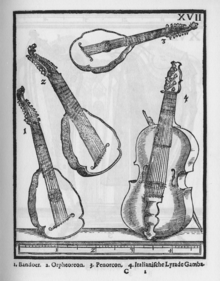Lira da gamba
The lirone (also: Lirone , lirone perfetto , arciviola as lira ) is a historic string instrument , which remained in Italy until the mid-17th century. As the lowest instrument of the Lira family, it was equipped with many strings , which ran on the fingerboard and partly next to it as a so-called drone . The lirone was used as a basso continuo instrument, especially in Italy . The construction of the instrument is mentioned for the first time in a letter from Atlante Migliorotti from Mantua from 1505. Thus the time of origin can be described more precisely. Initially, fewer strings were stretched. Later the lira was built with additional strings. The sixteen-string lira da gamba is an instrument that can be dated to around 1600 through tracts.
A traditional tuning of the Lira da Gamba (with Praetorius) is Ges-des for the drone strings, and A-es-Bfcgdaeh-fis-c sharp for the shortened strings.
Like a viola da gamba, the lira da gamba was usually held between the knees, and like this mostly had frets (delimitations for the pitches) and between nine and sixteen strings. A flat bridge allowed rich chordal playing, which is why this bass lira was particularly suitable for accompanying solo singing . Cardanus wrote in 1550: "The lira is partly used in connection with the human voice. It is, so to speak, the instrument of the gods, as it is usually described that they play it ...".
Other designs
The Meyers encyclopedia of 1905 states that the instrument was built in two other sizes:
- as Lira da Braccio with seven handle and two drone sides, tenor instrument (held by the arm)
- as Archiviola da lira (“Lirone” or “Accordo”) with up to 24 strings, double bass instrument (for musical reasons, the chordal use of an instrument in the double bass position seems doubtful from today's perspective).
literature
- Wolfgang Ruf (Ed.): Riemann Musiklexikon . 13th edition. Volume 3. Schott, Mainz 2012, ISBN 978-3-7957-0006-5 , p. 220.
- Imke David: The sixteen strings of the Italian lira da gamba. Orfeo-Verlag, Munich 1999, ISBN 3-9806730-0-6 .
Web links
- Photo and audio samples
- Description on the pages of an instrument maker
- Video of a consort with Lirone
Individual evidence
- ↑ Erich Valentin : Handbuch der Musikinstrumentenkunde. Gustav Bosse, Regensburg 1954, p. 427.
- ↑ http://www.zeno.org/Meyers-1905/A/Lyra+%5B1%5D?hl=lirone



